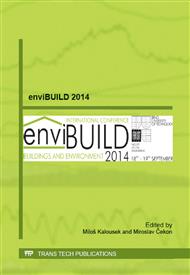p.362
p.367
p.371
p.377
p.381
p.386
p.390
p.395
p.399
Investigation of Useful Daylighting during a Day
Abstract:
Annual availability of daylight depends on exterior luminous conditions. If sunny sky is presented the interiors are illuminated by direct sunlight and diffuse skylight or only by skylight in dependence on the orientation and cloudiness. Under sunless situations only skylight is source of daylighting. The minimum illuminance expressed by Daylight Factor is required for performance of visual tasks by the Slovak standards. Traditionally, the overcast situation with exterior illuminance 5000 lx represents this condition. According to recent studies the occurrence of overcast sky in a year is not dominant in Europe and new metrics are looking for. It was published that minimum 100 lx and adequate of 300 – 500 lx is sufficient for the healthy and comfortable indoor environment. Direct sunlight can produce glare and visual discomfort. Bratislava daylight measurements show that such situations can occur often during a year.The typical daily diffuse and global illuminance courses were selected from Bratislava measurements. The periods in the day of useful daylighting, periods of exterior illuminance below 5000 lx and direct irradiance above 120 W.m-2 when sunshine can cause glare and overheating were identified in a classroom. Paper presents achieved results, their evaluation and discussion.
Info:
Periodical:
Pages:
381-385
Citation:
Online since:
October 2014
Authors:
Price:
Сopyright:
© 2014 Trans Tech Publications Ltd. All Rights Reserved
Share:
Citation:


